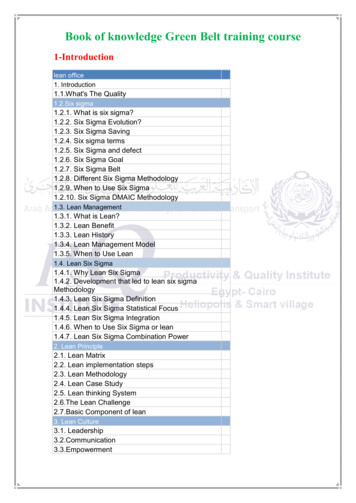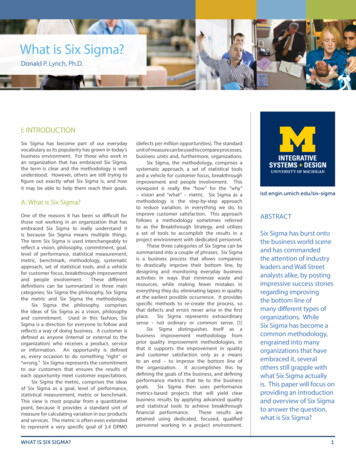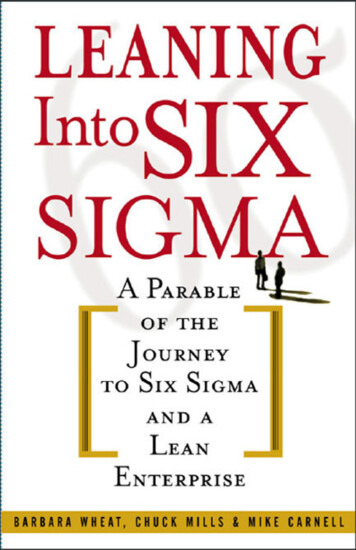
Transcription
Digitized by the Internet Archivein 2019 with funding fromDuke University gedOOhear
PRICE 25 CENTSTHE SIX WHO WERE HANGED(By CLEM. G. HEARSEY)IThis book contains a graphic pictorial andnarrative description of the history-making execu tion at Amite, La., May 9, 1924, when six menpaid the extreme penalty on the gallows for themurder of one. The three scenes of the actualexecution contained in this book are among themost unusual photographs in the world.
The author has no apology to offer for thisbook; it is the unfolding of a story whose “light est word should harrow up the soul and freezethe blood”.It is an impartial narrative, but it bitterlyarraigns Society as a Monster of Cruelty, andpoints to the conclusion that Death by Hanging,as judicial punishment, has no part with civiliza tion.Society must be protected from its undesir able units, yes, but Society has passed the SavageState, and in the application of its system of Crim inal Correction, it should not exercise the Spiritof Vengeance.If Capital Punishment must stand, let ushave, not “Lex Talionis”—the Law of Retaliation—but a humane infliction of the Death Penalty.-—JBV 1 Ij'Copyright, 1924ByClem. G. Hearsey
THE SIX WHO WERE HANGEDBy Clem. G. HearseyThe Gallows Tree ripened to its grim harvest in thepalisaded inclosure of the jail at Amite, La., on a Friday,the Ninth of May, and the fruit for the Feast of Deathnumbered six.In three creaking, crashing stanzas, the scaffold sangits Hymn of Doom, and each period carried with it, theghastly snapping of neck bones, and the straining andstretching of bound and hood-winked bodies as they swayedat the rope’s end.Six died for one, and the agony of the six, carryingthrough three years of imprisonment, was perhaps greateratonement than even the sternest System of Law mighthave required, could that agony have been placed in theScale of Justice and weighed against the enormity of thecrime for which the courts demanded payment.The agony of three years, even before its grim climaxof the quivering trap doors had been reached, was terrific,sombre with the touch of the heaviest tragedy, and the hap less six, buffeted by the mailed fist of Fate, lived in tor ment, between hope and dread.Even in the gloom of first imprisonment, and long be fore the gaunt skeleton in wood, which was finally to gripthem in its throttling embrace of death, had cast its shadowacross' their hopes, theirs was the conviction that theywould escape the Law, and that any penalty paid by them,would be but a partial penalty—a term of years in the peni tentiary at the most.These six men, Natale Deamore, Rosario Leona, JosephBocchio, Andreas Lamantia, Joseph Giglio and JosephRini—they are named in the order in which they weregroomed by the Deathsman—relied upon their friends, thestrong and influential forces behind them, to save themfrom the law, and late in the evening before their execution,and just as the bugler down in the court house squaresounded “taps”, Rini and Giglio, their fingers gripping thebars of their cells, told newspaper men and sheriffs, who1
had come to bid them good-night, that they did not be lieve that they were to die on the morrow, and felt confidentof being saved before the hangman reached them.They were the six who died for one—Deamore, Leona,Bocchio, Lamantia, Giglio and Rini, and the one who diedat the hands of the six, or so the law declared, was DallasCalmes, peaceful restaurateur, and hotel-keeper of thelittle town of Independence, La.The story is best told in its slow and sensational un folding, from the morning of May 8, 1921, when the murderwas done, to the afternoon of May 9, 1924, when Justice,as man writes it, was satisfied with the scaffold offering.It was in the quiet little village of Independence, nestl ing sleepily on the first slope from the lake marsh, thatCrime; paying its heavy toll to death, stalked to the thrill ing accompaniment of a woman’s shrill screams, the sharpstaccato of revolver shots, and the gasping groans of adesperately wounded man.Dallas Calmes, the village inn-keeper, or restaurantproprietor, was the victim of the storm of bullets; hisshrieking distracted wife crouched on the ground besidehim, holding the bloody head on her lap, and slinking awayin the darkness of the early morning to the chugging auto mobile where Joe Bocchio and Joe Giglio awaited them wereRoy Leona, Joe Rini, Natale Deamore and Andreas La mantia.Murder was committed there in the blackness of thatMay morning—Calmes gasped out his life in his wife’sarms—and on another May day, three years after, as asequel to that tragedy of unerring pistol fire, there wasanother and more hideous revel of Death and Pain whenthe six men—Bocchio, Giglio, Leona, Rini, Deamore andLamantia were groomed by the hangman and swung fromthe tall gibbet.The murder and the execution of the slayers make upone of the most startling pages of criminal history of thepast decade. It was crime which aroused the indignationof a country parish known for its turbulence in formeryears; there was ever the threat of night riders stormingthe prison and taking the culprits out to the forest as gal lows’ tree fruit, and leading men of the district had toexert all their eloquence to calm the fury of the people.That was while the men were in jail in the little townof Amite, the county seat of Tangipahoa Parish, sixty miles2
from New Orleans, undergoing their two trials. The longterm of their confinement was in the massive, steel-linedParish Prison in New Orleans, where they were held underthe watchful care of Captain Archie Rennyson, the prisongovernor, for safe keeping.It was during the last days of their captivity that thecase of the six who were hanged assumed something of aninternational aspect.Every legal means had been ex hausted ; the courts from the District Court of Tangipahoato the United States Supreme Court had sealed the men’swarrant to the gallows; Governor Parker, although threat ened by Blackhand letters, genuine or spurious had an nounced that no clemency would be shown the murderers,and the majority of the members of the Board of Pardonshad made clear that their ears were deaf to pleas of mercy.It was then that the Chancellor of the Italian Con sulate in New Orleans, Cavallero Papini, bore to GovernorParker at Baton Rouge, the State Capital, a letter fromPrince G. Gaetani, the Italian Ambassador at Washington.His Excellency, the Ambassador, wrote unofficially, but hepolitely advanced a request that the six men might bespared the gallows and sent to prison for life terms. Heurged that Italy had long since abandoned capital punish ment as having no part with civilization, and he thoughtthat a commutation of the sentence might serve to furtherpromote the good feeling so long existing between the an cient kingdom of southern Europe and the great republicof the West. While Governor Parker refused to commenton the Ambassador’s letter, the appeal from the ambassa dorial source did not move him from the course of HighJustice as he saw it, and work proceeded on the gallowsbuilding in the jail yard at Amite.The crime for which the six men were required to paythe law’s heaviest penalty is a picture of banditry, set ina frame of murder. Tangipahoa Parish is the great centerfor the strawberry culture of the Delta country, and in In dependence is the Farmers’ & Merchants’ Bank, wherethe owners of the rich fruit acres and the berry pickersdeposit their money after the season’s successful work.As the story in its bloody course runs, the six Italians,meeting in New Orleans, plotted to rob the bank in Inde pendence.Roy Leona and Joe Giglio came to the great southern3
city from Chicago, at the end of April, 1921. They camewith the intention of “bootlegging”, making wine andwhiskey for the thirsty trade, selling it at a high figure andamassing a great fortune, as others before them had done.Vito de Gorgio, a brigand at heart, first devised the schemeJoseph Giglioof the bank robbery, de Gorgio was no participant in theraid, but remained in New Orleans, and later going to Chi cago was killed in a brawl. “It would be easy work,” saidde Gorgio; “all you need is nerve, and you can make a get away with a lot of money.”Leona, who was something of a ring leader in theaffair, as his confession indicates, interested Lamantia andRini, New York Italians not long in New Orleans, in theventure, and Deamore, once a knife sharpener but laterinterested in an automobile repair shop, was pressed intoservice, as he knew roads for automobiles from New Or leans to Independence, and in and out the swamps andforests. Bocchio had just come in from Chicago with 300in his pocket intending to return to Italy to see his mother,and as he was an automobile mechanic and chauffeur hewas requested to drive the little Hudson car.The six bandits left New Orleans in their car on aFriday afternoon, and made a difficult run, because ofengine troubles. They spent Friday night with a country man of theirs, named Giamalva, way up on the river road,and the next afternoon. May 7th, they started on the lastlap of their dangerous journey in their uncertain machine.4
Late at night they stopped in the thick woods near Inde pendence, and waited for the dark of the morning for theirwork. The automobile resumed its journey and was parkedseveral blocks from the bank and the robbers went totheir work.Next to the bank was Calmes’ little restaurant, andthe yards of the two places were as one. The robbers, ingetting through a fence, overturned some boards, and Mrs.Calmes was aroused from sleep. She awakened her hus band, and Calmes, with his revolver in hand went to theback door, threw it open, entered the yard, saw the darkforms of several men and cried “Halt there!” The answerto his command was a hail of bullets, and as Calmes fellmortally wounded he returned the fire.The men escaped in the blackness of early morning,and Mrs. Calmes supporting her dying husband in herarms screamed for help. The chase was taken up at onceby Sheriff Lem Bowden, the man with the steel blue eyesand desperate courage, and in less than twenty-four hours,the six were in prison. They made their first break for liber ty in the automobile, but when the pursuit was hot theyJoseph Riniabandoned the machine in the swamps and separated. Threewere taken together, after exchanging shots that had noeffect with the sheriff’s posse, and the others were arrestedindividually late on the day following the killing, in adja cent villages. They had with them sawed-off shot guns, re volvers and dynamite. Bloodhounds, common in Louisiana5%
in man hunts, played a successful part in running down theculprits.As a bloody connection with the crime in Tangipahoa,a connection the police recognized but could not establish,two Italians were found shot to death in an automobile nearthe Industrial Ship Canal in New Orleans.The prisoners were taken to New Orleans as the author ities of Tangipahoa wanted the law to take its course andfeared the Vengeance of Night Riders, were the men de tained for any great length of time in the weak Amite jail.They had two trials, appeals to the State Supreme Court,the United States Supreme Court and hearing before thePardon Board, but the demands of Justice pointing towardthe gallows were maintained.The execution was set for three years and one dayafter the killing of Calmes.It was a long, hard siege for Capt. Rennyson, the Pris on Governor, and his deputies—the stay of the condemnedmen in the Parish Prison at New Orleans—and the lastfortnight of that stay was a series of sensational happen ings. First Leona confessed as having been the only oneof the six who fired at Calmes; then Deamore went insane,or pretended violent madness; Bocchio, the student whowore eyeglasses, fell into settled melancholy, and the otherthree lost their nerve almost to the verge of a breakdown,even Rini forgetting to fondle and play with his little Chi huahua dog, his cell companion for more than a year.And during the recent days Captain Rennyson re ceived strange letters. One sent from a remote postofficein North Carolina offered him 50,000 with an additional 25,000 to be given to Superintendent of Police Molony toallow the men to escape, and one threatening him withBlackhand vengeance. These letters were not seriouslyconsidered.As the sands of their mortal days ran lower in Life’sHour Glass, the state of the six men presented the awfulpicture of wrecked and shattered nerves, and emotionalismtouching the very fringe of stark madness. Deamore wasthe first to break entirely, and setting a lot of papers aflamein his cell and smashing stools and benches furiously, hecried that the whole world was on fire and that he wasbeing consumed. His ravings carried on intermittently un til his voice choked in the gripe of the hangman’s noose.6
Leona, after his confession that he alone had fired thefatal shot and that the other five had had no part in thekilling of Mr. Calmes, showed a phase of emotional insan ity. He paced ceaselessly to and fro in the narrow confinesof his cell, and would occasionally exclaim: “I am deadnow, already am I dead; they cannot hang me, because adead man would not look well dropping through a gallowstrap”.One afternoon he showed Captain Rennyson a spool,carefully whittled in the shape of a bullet. “This they shotthrough me,” he cried; “I am dead, they cannot hang adead man.”Captain Rennyson was alarmed, and well he might beas the character of the spool carving pointed to the factthat Leona had somewhere concealed in his cell a very sharpknife. Leona was taken to the bull ring, stripped andsearched by deputies. Nothing was found. Neither wasthe knife in evidence in any corner or hiding place of thecell, and the incident for the time was closed.Lamantia, always sad-eyed, and appealing in voice andaction, maintained a surprising calmness through the clos ing days in the Condemned Row at the Prison in New Or leans. With his face close to the steel lattice work of hiscell, he would daily ask the visiting newspaper men: “Anygood news for us boys outside; you think we have anychance?” Evasive answers expressing the negative wouldgenerally wring from him a deep sigh, and the remark: “Oh,we did no killing, how can they hang so many men whoare innocent!”A little dog, not much on hair, but with big pointedears and a stub of a tail nervously wagging, lay on JoeRini’s bed, staring with large inquisitive eyes through thecross net work of steel bars, at the group of men in thelong corridor of condemned row. It was the evening ofTuesday, the day before the men were removed to Amitefor the hanging.The little dog was a pathetic picture, she seemed tosense the impending doom which hung like a pall over hermaster, and whimpers and growls expressed the varyingcanine appreciation of the visit.Captain Rennyson, the prison governor, and newspapermen were in the party, and as Rini laced his fingers throughthe bars and leaned over the bed on which the dog lay, the7
devoted animal stood up on her hind legs and placed herfore-paws affectionately on the man’s side.“Toots she love me very much,” said Rini with a sadsmile, “and me when I go next Friday, I think of Tootsand wonder for her, where she go and who will be goodto her.”Poor little Toots had lived for more than two yearsfrom whining puppyhood in the cell with Rini. She cameas such a tiny dog, hardly with her eyes opened, and Rininursed her on the bottle through the weeks of crying in fancy to the strength of playful canine adolescence.Toots was a Chihuahua or hairless dog. She hadhair but not too much, and what hair there was workedout into beautiful white and brown spots.The dog certainly knew that some heavy woe was im pending and all day long during the final death watch, shemoped on Rini’s bed, and cried and whimpered in her sleep.“You see the dog,” said Rini, that last evening in theNew Orleans Prison; “she knows something going to hap pen, and already she begin her cryin’. Toots, when I amgone, maybe my father take her and love her, because Iloved her and she loved me.”Deputy Sheriff Elliott gave Toots to Rini, and the con demned man’s love or his dog, in the face of his greattrouble, demonstrated at least one noble and redeemingcharacteristic.Early the next morning, shackled hand and foot, andready for his death journey to Amite, Rini took an affection ate farewell of the whining, whimpering Toots. He heldthe dog on his lap until it was time to go, and then rais ing the protesting, plaintively howling animal with diffi culty in his steel girt hands, he kissed her several times onthe forehead, and with tears streaming down his cheekspassed her to Deputy Sheriff Elliott.In the bull ring, just in front of Rini, Guy, Cap tain Rennyson’s magnificent great Dane, crouched on hishaunches, surveying with soft, questioning eyes, the cryingstruggling little dog in Deputy Elliott’s arms. Toots sawthe bulky Guy, but could not appreciate the sympathy ex pressed in his gaze, and struggling to be free, she yelpedand barked in a canine hysteria, until Elliott removed herto the Captain’s room upstairs. The sympathetic Guy, withnever a resentful growl, arose slowly from the floor and8
with drooping tail moved out of the bull ring, to his quar ters in the sheriffs’ office.Sheriff Bowden, of Tangipahoa, with District Attor ney Matt Allen, who conducted the prosecution of the Ital ians at their several trials in Amite; Dr. W. H. McClen don, the coroner of the Parish, and several deputy sheriffsarrived Tuesday night in New Orleans, to take charge ofthe prisoners and carry them to the Hard Mart of CriminalTrade, where they were to yield their lives for a life theyhad taken, as the law required.The last two days had produced new and startlingphases to the internationally celebrated case. Sheriff Bow den had accepted Governor Parker’s tender of troops, andAdjutant General L. A. Toombs had his soldiers in bar racks under command of Captain Carter all ready for thejourney to Amite. The soldiers were to guard against anyattack that might be made on the prison train by friendsof the condemned, planning a rescue, and also, as somesuggested, to protect the prisoners from possible mob vio lence, should a stay of execution be ordered at the lastminute.A determined effort had been made in the United StatesCourt by the attorneys for the Italians to obtain a Writ ofError and Stay of Execution. The legal battle was foughtby Girault Farrar, A. D. Henriques and George Gulotta,representing the condemned men, and T. Semmes Walmsley, Amos Ponder, District Attorney iUlen, District At torney R. H. Marr, of Orleans Parish, representing theState.Both Sheriff Bowden and George Williams, the Crim inal Sheriff of Orleans Parish, who were made defendantsin the writs were present in court. Judge Rufus Fosterwho heard the proceedings denied the writs late Tuesdaynight, and the last barrier to the gallows was removed.Mr. Farrar at once announced that he would leave forWashington that night to lodge an appeal with the UnitedStates Supreme Court. No stay of execution was allowedhim, and under his plan he would have to leave Tuesdaynight to reach Washington in time to present his case.Mr. Farrar did take thefound that his law partners inwith the necessary papers, soBay St. Louis and returned to9train for Washington, butthe case were not on boardhe abridged his journey atthe city.
A fraction of a second before the hangman (stooping) cut the rope, the photographer took this scene.Roy
Captain Rennyson, because of his long experience inprison management, volunteered to render Sheriff Bowdenevery assistance possible in the execution of the six, andwhen the sheriff arrived Tuesday night, he had ready theone hundred feet of five-eighths rope, the six black capsfor the murderers, and the mask for the hangman.Gathered in the Captain’s office that night were thesheriff and his party from Amite; Sheriff Williams, FrankSullivan, former criminal sheriff, Col. John P. Sullivan,General Toombs, Superintendent of Police Molony, andothers with a number of newspaper men, local and frompoints in the north and east.Captain Rennyson showed the black caps, and SheriffBowden’s curiosity to see how they were adjusted, wassatisfied by a newspaper man who tried on one of thehoodwinks, and then fitted the hangman’s mask to his face.The black caps were there, so was the executioner’smask, and to add to this collection of horrors, Captain Ren nyson took from an old armoir in a corner of the room amass of dangling, twisting white cords. “These are fortheir legs, when they are standing on the trap,” he ex plained. It is necessary that a man in execution should becarefully pinioned, as if his neck is not broken and he strug gles in strangulation, his contortions would not be pleasantto look upon.”Sheriff Bowden, who was not in the best of health, layat restful ease on Captain Rennyson’s bed, and seemed in terested in the accounts the Prison Governor gave of theactions and mental conditions of the men. Captain Ren nyson, although long associated with the management ofa big prison, and in daily contact with the ugly phases ofprison life, is nevertheless a humane man, thoroughly ap preciative that all prison codes need reformation, and thatSociety to maintain Civilization’s high standards, must getaway from the present barbarous forms of capital punish ment.The Captain had known the doomed Italians for allof three years, as the better part of that time they spentin his jail, and he learned to like them. They were goodprisoners, always polite to visitors and never violatingrules, or taking advantage of their unfortunate position,and imposing upon Captain Rennyson’s kindness.“They are in a rather bad state tonight,” Captain Ren-11
nyson informed Sheriff Bowden, “and naturally so, but Idon’t think that they are going to give us any trouble.”One of the newspaper men present had witnessed thir ty-six executions, and was full of gloomy scaffold lore,which he dispensed with a wealth of hideous detail for thebenefit of Sheriff Bowden, who was something of a strangerto the forms and ceremonies attending the fatal exerciseof the Law’s severest mandate.Frank Sullivan, the former sheriff, smiled and ob served, indicating the newspaper man: “There he is sheriff,you never see him in the prison until around execution time,ask him, he can tell you all about it.”“In all the men you have seen hanged,” asked SheriffBowden from the bed, “was there ever an instance whereit was necessary to carry the culprit to the scaffold?”“No,” returned the writer; “I have seen some weakand faltering victims of the noose, but never a man in theactual state of collapse.It’s true that Sam Sparo wasclose to a frenzy of fear as he stood on the gallows out therein the prison yard. He had diced with Death and lost, andwas to give his own life for having abridged the dolefuldays of poor Tony Luciano, with several pistol shots in theback. Sparo was weak, swayed on the gallows with tremb ling limbs, as they trussed him up for the drop with sleeknew ropes, and had it not been for big ‘Doc’ Briney, oneof Archie’s deputies, he wmuld have thrown himself overthe gallows rail to the hard paved yard fifteen feet below.‘Doc’ caught him just in time.“And then when Hangman Johnson came, in funerealrobes and black mask, and Sparo saw the darkly repulsiveface over his shoulder, he cried in a spasm of fear ‘Hurryupa, Johnson, work queek!’ Johnson worked quick as healways did and as the trap sprung, and Sparo’s body tookthe awful plunge, a muffled shriek came from beneath theblack cap. The shriek had hardly begun, ere it ended, ina loud crack, that seemed to merge with the hollow echoof the clanging trap.“I was just in front of the gallows, and heard thecrack plainly. It was Sparo’s neck violently breaking, andas Coroner O’Hara’s examination showed later, the wholeneck bone structure had been shattered and splintered;that was why the snapping was so loud and distinct amongthe other gruesome gallows sounds.12
“No, Sheriff, men don’t generally go to the scaffold ina collapse; it always seemed to me that they inclined toLady Macbeth’s advice to her husband about to kill thesleeping Duncan, and screwed their courage to the stick ing place, so as not to fail in their painful passing out.“I think you will have no trouble with your prisonerssheriff, and from my experience, I dare hazard the opinionthat they will go boldly to their fate. There’s one at leastI’m sure of and that’s Rini.”“What was that, Rini?” inquired Captain Rennyson.“Yes, Rini,” was the answer.“They’ll have to carry him,” was the prison governor’sdoleful prediction, a prediction which was not borne out bythe events of the tragic day of execution at Amite.The night wore on, and the prisoners at odds with sleeppaced or crouched disconsolately in their cells looking for ward to the morrow’s journey.Bocchio, the poor, weak student, who had once con templated Holy Orders as his life’s mission, lay back onhis bed against the steel lattice work; his gold rimmedglasses were on his well shaped nose; his eyes were closed,and the peak of the cap was drawn down on his forehead.In a husky monotone he asked over and over “What timeis it, what time is it?”Leona paced restlessly back and forth in his cell, andDeamore in hoarse tones roared his melancholy plaint, withwildly tossing head and violently swinging arms. Lamantiaasked anxiously of the death watch if it was true they wereto be taken to Amite in the morning; Rini nervously fondledhis dog, and Giglio sat staring out into the condemnedcorridor, remarking every now and then as though to him self : “It’s a shame to hang five innocent men, GovernorParker did not treat us right”.“Try to get a little sleep, Joe,” advised a newspaperman accompanying Captain Rennyson on a late visit tothe tier.“Sleep,” answered Giglio, with a hard smile, “I’d liketo; why, I haven’t slept for two nights; with a crazy manon one side yelling that the world’s on fire, and another oneon the other side bawling out that he’s shot and alreadydead and can’t be hung, I had a fine chance for quiet rest.”Giglio, always courteous, smiling and polite, was justa little surly on his last night in the New Orleans prison.13
The iron tongue of night was telling twelve, when thegroup in the Captain’s room upstairs thinned out. Theyhad discussed murders, hangings, executioners and suchtopics that accord well with jails and prisons, and theveteran newspaper man took occasion to voice a protestagainst the horrible modes society follows in doing awaywith its objectionable units.“Hanging is a barbarous thing,” the writer observed,“so full of terrific chances for protracted suffering. Youremember the case a few years ago, upstairs there in theTower, don’t you, Captain? It was one time that I sawyou moved almost to nervous weeping.”“God, how that poor wretch cried in choked andwheezy tones for Heaven’s mercy, as he writhed at the endof that strangling cord. For twenty minutes after the dropfell, he swayed, spun and fought, not for life, but to findthe Portals of Death, where in the lethal shadows, his soulmight sleep, and the bodily torment end.“I will never forget that sigh which came from underthe black hood when the rope had slipped in place and theexhausted frame quickly yielded its failing energies to thegrip of strangulation. It was a deep, thankful sigh, a sighof relief, and the quiver of death speedily passed down thebody. ‘Thank God, it’s over,’ murmurred in an undertone,the good priest Father Helinski, so faithful in his attend ance on gallows victims.“In my experience as a newspaper man I have seenmany criminals strangle horribly, and such a mode of cap ital punishment has no place in a civilization such as is ours.“What do you think of the electric chair?” asked Sher iff Bowden.“I know nothing of electricity, and have never seenthe chair in operation,” answered the old reporter, “but Iam told that there are some constitutions which resist thecurrent until their very flesh fries and burns.”“How about the guillotine?” advanced a young re porter, with only four hangings to his professional recoi’d.“It may be quick and certain if the machine is good, butdisgustingly bloody and unsightly”, commented the veteran.“And then, too,” he went on, “if you’ve read muchFrench History, dating from the Revolution, and modernFrench criminal annals, you will find instances where theguillotine had its fearsome bungles. When they executed14
*»v . .? „f . .%C". .'W " A* -: n' zmm*** ’ , y . . «**»**«Roy Leona, on the left trap, is watching the hangman tie the hands of Natale Deamore, on the right trap.T te'vA
Chalier in Lyons, the National Assembly sent down fromParis a worn out ‘Red Widow’ with ungreased grooves anddull knife blade. The result was the knife fell seven timesbefore Chalier finally sneezed in the sack. This case hassome more modern parallels, so we may dismiss the guil lotine as being in a measure uncertain.”“What mode of capital punishment would you sug gest,” Sheriff Bowden wanted to know.“The Lethal Chamber,” was the ready reply. “Thereis, a clean, a certain and a painless way for Society to riditself of its objectionable units. There could be no failurein this; have a nicely fitted up condemned chamber, withthe gas openings concealed from view. Set no certain timefor the execution, but have a period of death during theterm of a week at the sheriff’s discretion. Drug the prison er’s food some night during the period, and when he hasfallen asleep turn on the gas. There’d be no strugglingtorture, no horror attending this, and the Lethal Chamberwould express the humane in legal executions.“Society is too far advanced to exact vengeance afterthe order of the old Lex Talionis, an eye for an eye and atooth for a tooth, and Society should be satisfied to destroyits criminals a
sulate in New Orleans, Cavallero Papini, bore to Governor Parker at Baton Rouge, the State Capital, a letter from Prince G. Gaetani, the Italian Ambassador at Washington. His Excellency, the Ambassador, wrote unofficially, but he politely advanced a request that the six men might be spared the gallows and sent to prison for life terms. He










